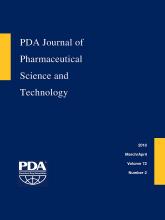Research ArticleResearch
Mechanistic Investigation on Grinding-Induced Subvisible Particle Formation during Mixing and Filling of Monoclonal Antibody Formulations
Benson Gikanga, Ada Hui and Yuh-Fun Maa
PDA Journal of Pharmaceutical Science and Technology March 2018, 72 (2) 117-133; DOI: https://doi.org/10.5731/pdajpst.2017.007732
Benson Gikanga
1Pharmaceutical Processing and Technology Development, Genentech, South San Francisco, CA; and
Ada Hui
2Late Stage Pharmaceutical Development, Genentech, South San Francisco, CA
Yuh-Fun Maa
1Pharmaceutical Processing and Technology Development, Genentech, South San Francisco, CA; and

References
- 1.↵
- Gikanga B.,
- Chen Y.,
- Stauch O. B.,
- Maa Y.-F.
- 2.↵
- Gikanga B.,
- Roshan-Eisner D.,
- Ovadia R.,
- Day E.,
- Stauch O. B.,
- Maa Y.-F.
- 3.↵
- Eibl R.,
- Eibl D.
- Werner S.,
- Kraume M.,
- Eibl D.
- 4.↵
- Eibl R.,
- Eibl D.
- Eibl D.,
- Peuker T.,
- Eibl R.
- 5.↵
- Sinclair A.,
- Monge M.
- 6.↵
- Cromwell M. E.,
- Hilario E.,
- Jacobson F.
- 7.↵
- 8.↵
- 9.↵
- Kiese S.,
- Pappenberger A.,
- Friess W.,
- Mahler H.-C.
- 10.↵
- Joubert M. K.,
- Luo Q.,
- Nashed-Samuel Y.,
- Wypych J.,
- Narhi L.
- 11.↵
- Randolph T. W.,
- Schiltz E.,
- Sederstrom D.,
- Steinmann D.,
- Mozziconacci O.,
- Schoneich C.,
- Freund E.,
- Ricci M. S.,
- Carpenter J. F.,
- Lengsdeld C. S.
- 12.↵
- Thomas C. R.,
- Geer D.
- 13.↵
- Virkar P. D.,
- Narendranathan T. J.,
- Hoare M.,
- Dunhill P.
- 14.↵
- Maa Y.-F.,
- Hsu C. C.
- 15.↵
- 16.↵
- 17.↵
- 18.↵
- 19.↵
- 20.↵
- 21.↵
- Suslick K. S.,
- Flannigan D. J.
- 22.↵
- Flannigan D. J.,
- Suslick K. S.
- 23.↵
- Ashokkumar M.,
- Griesser F.
- 24.↵
- Cains P.,
- Martin P.
- 25.↵
- 26.↵
- Bhushan B.
- Kennedy F.
- 27.↵
- 28.↵
- Dhankhar P.
- 29.↵
- 30.↵
- 31.↵
- 32.↵
- 33.↵
- Bowen M.,
- Turok B.,
- Maa Y.-F.
- 34.↵
- Gikanga B.,
- Turok R.,
- Hui A.,
- Bowen M.,
- Stauch O. B.,
- Maa Y.-F.
- 35.↵
- Bernard J. G.,
- Singh S.,
- Randolph T. W.,
- Carpenter J. F.
- 36.↵
- 37.↵
- Kalonia C.,
- Kumru O. S.,
- Prajapati I.,
- Mathaes R.,
- Engert J.,
- Zhou S.,
- Middaugh C. R.,
- Volkin D. B.
- 38.↵
- Kotronarou A,
- Mills G,
- Hoffmann M.
- 39.↵
- Zhu C.-P.,
- Huang B.,
- Han Q.-B.,
- Ni C.-H.,
- Zhu G.-J.,
- Liu M.-H.,
- Shan M.-L.
- 40.↵
- Rajanandam K. S.,
- Madhu G. M.,
- Thomas A.
In This Issue
PDA Journal of Pharmaceutical Science and Technology
Vol. 72, Issue 2
March/April 2018
Mechanistic Investigation on Grinding-Induced Subvisible Particle Formation during Mixing and Filling of Monoclonal Antibody Formulations
Benson Gikanga, Ada Hui, Yuh-Fun Maa
PDA Journal of Pharmaceutical Science and Technology Mar 2018, 72 (2) 117-133; DOI: 10.5731/pdajpst.2017.007732
Jump to section
Related Articles
- No related articles found.





